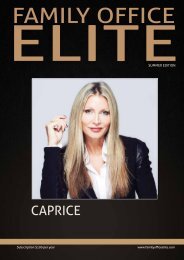Family Office Elite Spring_16
Family Office Elite Magazine, the wealthiest audience in the world. Family Office Elite Magazine is a very high class bespoke publication and a porthole to the ultra-wealthy family offices and UHNWI sectors. The magazine includes editorials from recent events and experts from the ultra-wealthy Family Office community.
Family Office Elite Magazine, the wealthiest audience in the world.
Family Office Elite Magazine is a very high class bespoke publication and a porthole to the ultra-wealthy family offices and UHNWI sectors. The magazine includes editorials from recent events and experts from the ultra-wealthy Family Office community.
You also want an ePaper? Increase the reach of your titles
YUMPU automatically turns print PDFs into web optimized ePapers that Google loves.
ALEXANDER BOGOMAZOV<br />
Dudakov, among others, to start collecting his works.<br />
Bogomazov exhibitions remained a rarity. The next<br />
were not held until 1991 – in Toulouse and Kiev.<br />
Another <strong>16</strong>-year lull ensued before St Petersburg’s<br />
Russian Museum hosted a Bogomazov show in<br />
2007. Such scratchy museum coverage does grave<br />
injustice to this pioneering artist, who is also (with<br />
the honourable exception of Kiev’s National Museum<br />
of Ukrainian Art) chronically under-represented in<br />
public collections.<br />
The third reason Bogomazov has anguished in<br />
undeserved obscurity is his status as a ‘Ukrainian’<br />
artist. As a result, he has been ignored by many of<br />
the exhibitions devoted to the Russian Avant- Garde<br />
in the West. ‘Ukrainian’ is, mind you, something of<br />
a misnomer: Alexander Bogomazov was Russian<br />
by virtue of his mother tongue and birthplace in<br />
what was then the Tsarist Empire. Yet, insofar as he<br />
spent virtually all his life in Kiev, Bogomazov may<br />
unquestionably be considered Ukrainian.<br />
He was educated at the Kiev Academy of Arts and<br />
spent almost all his creative life in the city – including<br />
his final, illness-wracked years as a polemicist and<br />
teacher at what by then was Kiev Art Institute. With<br />
its hills, escarpment, twists, turns and vistas, Kiev is<br />
his city. Bogomazov wrote: ‘Kiev in its plastic outlines<br />
is full of beautiful, varied and deep dynamism.<br />
Here the streets thrust into the sky, the forms are<br />
tense, the lines are energetic; they fall, split up, sing<br />
and play. The verticals of poplars and mountains<br />
slash across the horizontals. The general tempo of<br />
life underlines this dynamism even more; it gives it<br />
what might be called an ordered basis and broadly<br />
flows over throughout, until it rests on quiet shores<br />
of the Left Bank of the Dnieper.’ Indeed, it is no<br />
exaggeration to say that Bogomazov is now regarded<br />
as the Ukrainian Avant-Garde artist par excellence.<br />
He is unquestionably worthy of this title. His<br />
theories, as outlined in his 1914 treatise Painting<br />
and Elements are considered prophetic – he wrote<br />
how the black square on the white background is the<br />
‘most finished form’ a year before Malevich, while his<br />
musings on rhythm, colour and line predate those<br />
of Kandinsky. Only with increased exposure and<br />
research will the legacy of this artist be assured. A<br />
personal exhibition, the first in his homeland since<br />
1991, is now planned at the National Museum of<br />
Ukrainian Art for the winter of 20<strong>16</strong> and archivists<br />
are working through the myriad of documents and<br />
letters, only a fraction of which have ever been<br />
published.<br />
The works chosen for this exhibition fall into four<br />
sections. The first is devoted to Bogomazov’s<br />
inspiration and support: his wife Wanda Monastyrska,<br />
whom he met in 1908. Two 1911 portraits of Wanda<br />
at this exhibition are intimate and touching. A 1913<br />
view of Wanda reading is more daring (they were<br />
now married). By 1915, his images of Wanda had<br />
evolved into something far stronger, more confident<br />
and sexually charged. Before 1915, Bogomazov<br />
painted or drew his wife on at least 30 occasions.<br />
The relationship between the diffident artist and the<br />
fiery, self-confident spouse (herself also an artist)<br />
was slightly unconventional.<br />
Bogomazov was smitten with Wanda on first sight<br />
but, initially, she rejected him. His persistence paid<br />
off and, by 1911, his images of Wanda had acquired<br />
an immediacy that suggests he had reason to believe<br />
in her change of heart. Their marriage in August<br />
1913 detonated what Dmytro Horbachov calls an<br />
‘explosion of creativity’ for Bogomazov, whose<br />
artistic career could have fizzled out into despair and<br />
emptiness without Wanda’s support.<br />
After his death from tuberculosis in 1930, Wanda<br />
single-handedly preserved the work of ‘her Sasha’<br />
from the Soviet authorities and Nazi invaders.<br />
We have obtained first-hand impressions of the<br />
97<br />
FAMILY OFFICE ELITE MAGAZINE



